Here is the new chapter for the story about FiiO's tiny amps' line-up: E6 has been in development for over a year now and ready to be launched months ago. But due to the respect for Westone, which has decided to bundle the new E6 with some of their IEM, the launch is delayed till now . I can't begin to tell you how impressed I am when I first received it. Will it beats E11? No. But will it out-do E5 several times over? Hell yes. For those who think E5 is nothing but toy, this is where FiiO is trying to prove to you how serious a tiny amp that cost much less than a decent meal can go.
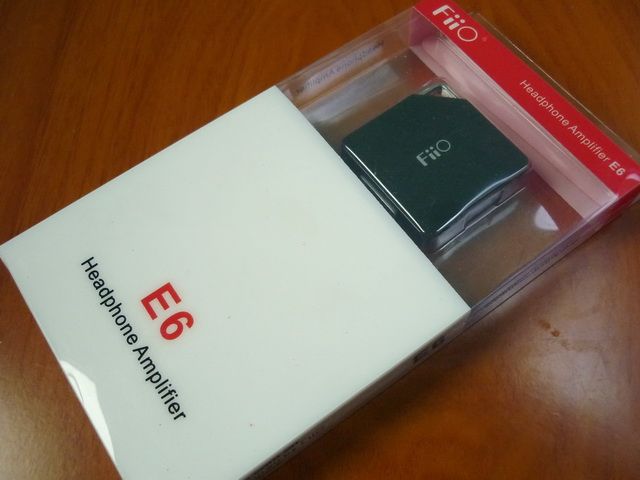
Tech Prelude
So E6 is using the same set of opamps as the E7, does they sound just the same? Well, yes and no. Yes is that the general sound signature of E6 is still consistent to other FiiO’s amps, clear and mostly transparent. No is that the actual design of the circuit has been changed. As told, E6 utilizes a different power circuit to provide true +/- power for the opamp to improve the performance instead of the old charge-pump design on E7. Well, I am not an electronic engineer so don’t ask me about the detail. All I can say is the E6 does sound better than E7 – and I will leave the detail for later.
SPEC
Spec is mostly the same as E5 / E7..
Output Power: 150mW (16Ω); 16mW (300Ω)
Headphone Impedance Range: 16 Ω ~ 300 Ω
SNR: ≥95dB (A weighted)
Distortion: <0.009% (10mW)
Frequency Range: 10Hz ~ 100kHz
Power Supply: Internal rechargeable Li-ion battery
Recharging: USB 5V DC 500mA
Size: 41mm x 40.2mm x 8mm
Weight: 16g
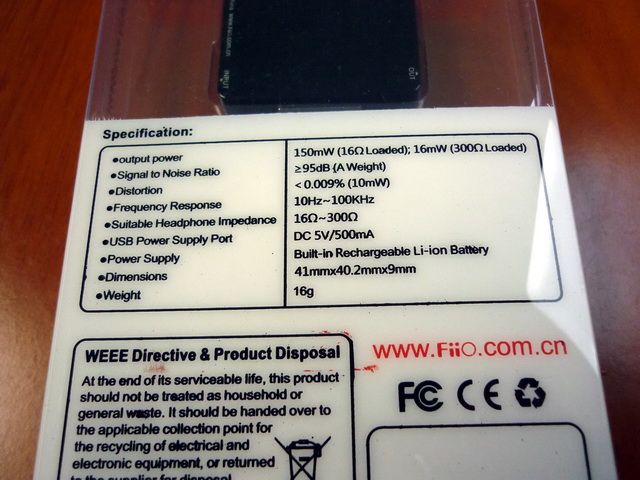
Packaging, Accessories and Build Quality
As you can see on the picture, the packaging is similar to FiiO’s own E1. Blister pack isn’t my favorite but I guess one can’t be choosy on a $30 amp. Accessories wise, there is an USB cable for charging, two 3.5mm-to-3.5mm interconnecting cables (one L-to-L three inches and one straight-to-straight 2.5 feet), and two transparent back clip. The back clip will fit into the triangular opening on the E6 and it is very secure. Also, the back clip is made out of polycarbonate and it is extremely strong (for a clip of this size). Just so you know, polycarbonate is the same stuff Mythbuster use for their blast shield most of the time. In case you do manage to break one, there is an extra clip waiting.


While the E6 does look a little cheap since it is all made out of plastic and extremely light (16g), the overall build quality, as you can expect from FiiO, is quite decent. The whole housing is glued tight and nothing is loose, including the shiny triangular slot that holds the back clip. The volume buttons feel really solid, so is the power/ EQ / hold switch.
One of the tests I have done is on electromagnetic Interference – basically it is the same cellphone test I have done on my E5 review. I placed the amp very close to my cellphone then I made a quick call to myself to check any RF interference. To my surprise, E6 is dead silent the whole time, not even when it was placed next to the cellphone.
Overall, I am pleased. While metal housing is classier, it really is the interference that I thought will be problematic for E6. Yet E6 is able to prove it is better than E5 in that regard.

Digital volume control on the side.
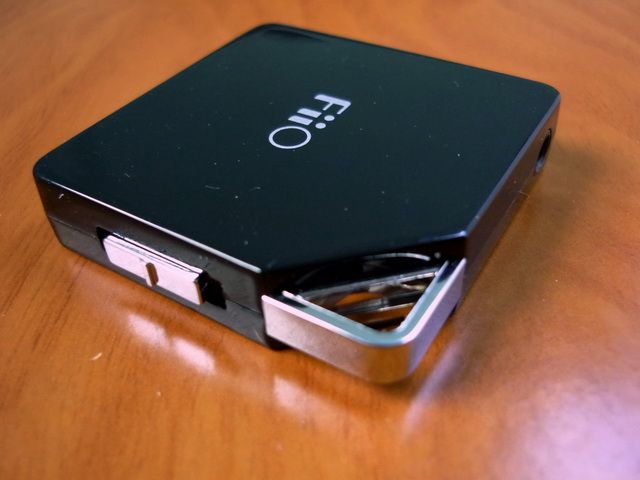
Battery Life
The listed battery life is 10 hours, which is the same as E5. Though I didn’t actually do a battery drain test, I did use it for over 6 hours or so between each recharge. I think the actual run time will depend largely how you use the amp, but 8~10 hours seems perfectly achievable to me.
Gain and Hiss
The old E5 has a gain of 5dB (3dB is double in signal), the new E6 is said to be 2.8dB higher than E5. For the RMAA test I did, the result indicate roughly a 3dB difference between E5 and E6, so that confirms the increased gain of 2.8dB – which totals the E6 gain to about 8dB. What that means is E6 can get really loud if you want it too. However, there available power is still limited by the opamp in use, so don’t expect E6 to out shine E11 in that regard. I have tested E6 on 150 ohm IEM like the RE262 and ER4S to low impedance IEM down to 16 ohm UE200. The results are all very decent. It might not able to sound as good as $100+ amp, but the performance is admirable for such a small device.
Hiss is an issue to E5 when it comes to loud volume. Basically the amp (E5) stays well-behave when it is in low volume. But hiss starts to increase once the volume is set to over half of the total volume. The reason is how E5 increases its volume - it is done by increasing the gain (which is different from the common method of limiting input signal like in cmoy). The downside of gain adjusted volume is that gain increment also means the internal noise will increase as well, and that is what causes E5 to hiss when the volume is up. On E6, the volume is also controlled with gain so hiss does exist. The good news is the hiss level is about half as much as E5 and like E5, only occurs when you set the volume to very high. What that means is, as long as you have a decent level of input, you shouldn’t find hiss a problem on E6.
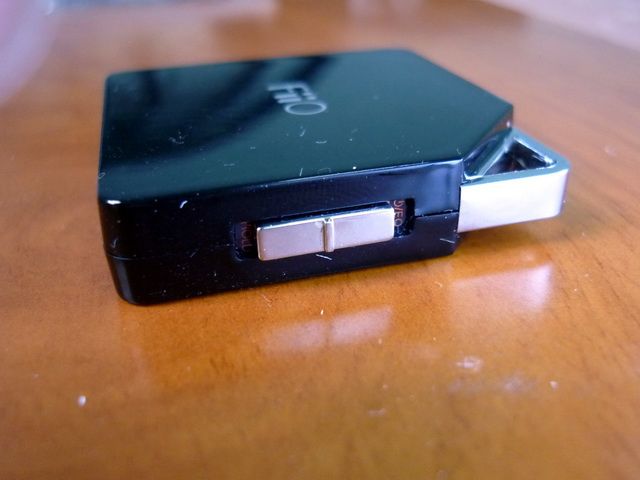
Pushing the power switch up for 3 seconds to turn the amp on/off. Push it once when the amp is on to switch between different EQ. Push the power switch down to lock the volume setting (hold).
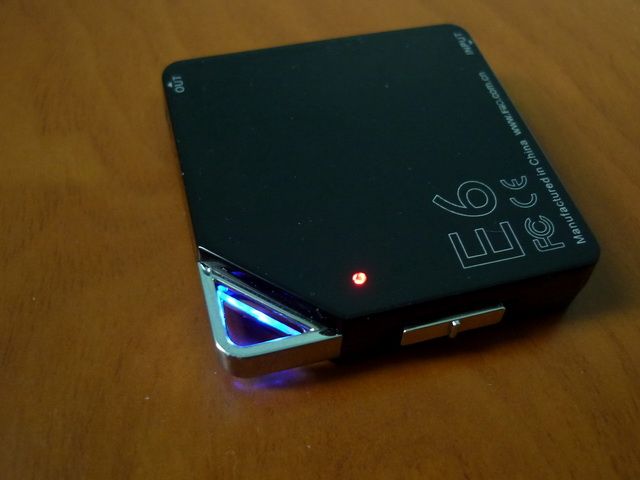
Blue light is the power on indicator (turns red when charging). Red dot shows the amp is on EQ1 (turns to blue for EQ2, purple for EQ3 and no light for flat EQ)
Sound Quality and EQ
So how do E6 compared to E5 and E7? Compared to E5, E6 (flat EQ) is cleaner, In fact, even cleaner than E7. It loses a tad of warm from the mid, but becomes crisper on the treble. Overall, E6 sounds a hair more extended and revealing than E7, which also means it sounds better than E5 by a decent margin.
How about JDS cmoyBB and SoundMAGIC A10? For cmoyBB, as I have mentioned from my cmoyBB review – it is better than E7 but not vastly. What cmoyBB does really well is on the rendering on space, layering and air, though it also carries an extra sense of lushness (which I see it more as a kind of coloration. Note: I prefer neutral amp). To me, E6 fits nicely between E7 and cmoyBB. However, that is assuming both are on flat EQ. Once E6 is on EQ2, the two are incredibly close with the same richness in sound – those who love their amp sounding rich will definitely like this. For A10, I always consider it to be comparable to E7 but come with a very different flavor. It is warm, full and musical. To me, E6 is technically more accurate but just like how A10 compares to E7, they are very different sounding. With EQ1, E6 can actually capture some of the warm and fullness of A10, though still not quite as musical and spacious.
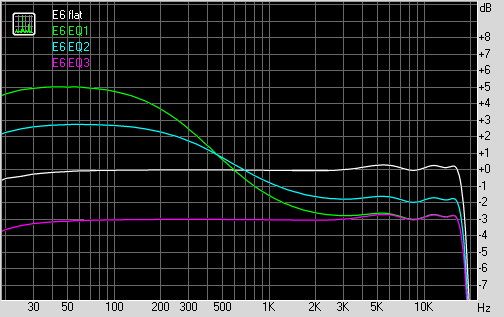
RMAA tested with 16 ohm load. Don't mind the ripple beyond 5kHz and drop off near 20kHz, it is caused by my soundcard. EQ3 was adjusted (-3dB) to show the difference to flat EQ.
So if you haven’t noticed, I just finish describe to you what I think really makes E6 a true gem – its EQ. It can be clean, lush, or warm and full on a push of a switch. Sure it is not going to turn into cmoyBB or A10, but the effects are still enjoyable and fun. Even without the improved sound quality from E7, the EQ on E6 alone will worth the investment. The one EQ I haven’t mentioned is EQ3, which is a 3dB reduction across the whole frequency range. Different from E7 which has a limiting input of 1.4V (any higher will clip), E6 is capable of 2V input. But for even higher input, E6 will still clip and render the amp useless. The EQ3 is basically a feature to prevent that from happening by lowering the overall gain so the amp can take a larger signal without clipping. In RMAA test, EQ3 performs as good as flat EQ except for the lower gain. I tested E6’s EQ3 on s:flo2’s line-out (which will clip E5 and E7) and it actually sounds pretty good - very comparable to S:flo2 headphone-out. Of course this is done to proof a point rather than any real practicality since the headphone-out is pretty good already.
So how about E6’s big brother, the E11? Besides being a bit more forward sounding, E6 lacks the overall resolution and authority to really compete with th3e much more powerful E11, which I do consider to be a class better than E6. But putting that aside, both are better amp than what their price tags would have want you to believe in.
*HifiMan RE0 is used as the reference IEM in the review. Sources include Sansa Fuze (LO), iPod Nano 4G (LO) and s:flo2 (LO)
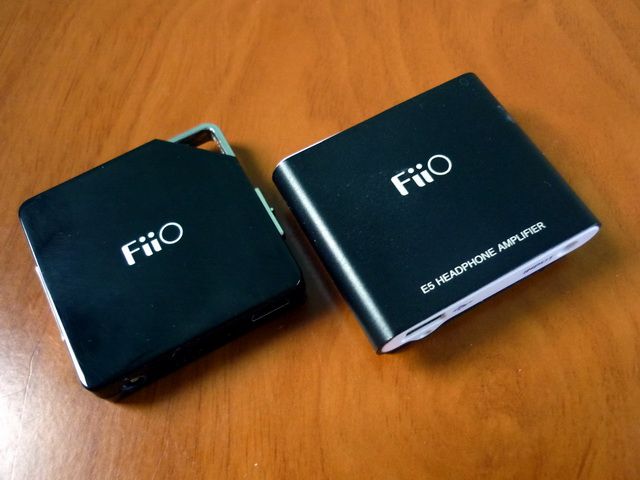
E6 (left) and E5 (right)
Verdict
As I was told that E6 took almost a year of development to get it right. FiiO has managed to address some of the weakness in old E5 / E7 and add some very useful features to E6. While it may be just an entry level amp that cost about $30, I think FiiO is again taking the concept of entry level to a new height with E6.

Tech Prelude
So E6 is using the same set of opamps as the E7, does they sound just the same? Well, yes and no. Yes is that the general sound signature of E6 is still consistent to other FiiO’s amps, clear and mostly transparent. No is that the actual design of the circuit has been changed. As told, E6 utilizes a different power circuit to provide true +/- power for the opamp to improve the performance instead of the old charge-pump design on E7. Well, I am not an electronic engineer so don’t ask me about the detail. All I can say is the E6 does sound better than E7 – and I will leave the detail for later.
SPEC
Spec is mostly the same as E5 / E7..
Output Power: 150mW (16Ω); 16mW (300Ω)
Headphone Impedance Range: 16 Ω ~ 300 Ω
SNR: ≥95dB (A weighted)
Distortion: <0.009% (10mW)
Frequency Range: 10Hz ~ 100kHz
Power Supply: Internal rechargeable Li-ion battery
Recharging: USB 5V DC 500mA
Size: 41mm x 40.2mm x 8mm
Weight: 16g

Packaging, Accessories and Build Quality
As you can see on the picture, the packaging is similar to FiiO’s own E1. Blister pack isn’t my favorite but I guess one can’t be choosy on a $30 amp. Accessories wise, there is an USB cable for charging, two 3.5mm-to-3.5mm interconnecting cables (one L-to-L three inches and one straight-to-straight 2.5 feet), and two transparent back clip. The back clip will fit into the triangular opening on the E6 and it is very secure. Also, the back clip is made out of polycarbonate and it is extremely strong (for a clip of this size). Just so you know, polycarbonate is the same stuff Mythbuster use for their blast shield most of the time. In case you do manage to break one, there is an extra clip waiting.


While the E6 does look a little cheap since it is all made out of plastic and extremely light (16g), the overall build quality, as you can expect from FiiO, is quite decent. The whole housing is glued tight and nothing is loose, including the shiny triangular slot that holds the back clip. The volume buttons feel really solid, so is the power/ EQ / hold switch.
One of the tests I have done is on electromagnetic Interference – basically it is the same cellphone test I have done on my E5 review. I placed the amp very close to my cellphone then I made a quick call to myself to check any RF interference. To my surprise, E6 is dead silent the whole time, not even when it was placed next to the cellphone.
Overall, I am pleased. While metal housing is classier, it really is the interference that I thought will be problematic for E6. Yet E6 is able to prove it is better than E5 in that regard.

Digital volume control on the side.

Battery Life
The listed battery life is 10 hours, which is the same as E5. Though I didn’t actually do a battery drain test, I did use it for over 6 hours or so between each recharge. I think the actual run time will depend largely how you use the amp, but 8~10 hours seems perfectly achievable to me.
Gain and Hiss
The old E5 has a gain of 5dB (3dB is double in signal), the new E6 is said to be 2.8dB higher than E5. For the RMAA test I did, the result indicate roughly a 3dB difference between E5 and E6, so that confirms the increased gain of 2.8dB – which totals the E6 gain to about 8dB. What that means is E6 can get really loud if you want it too. However, there available power is still limited by the opamp in use, so don’t expect E6 to out shine E11 in that regard. I have tested E6 on 150 ohm IEM like the RE262 and ER4S to low impedance IEM down to 16 ohm UE200. The results are all very decent. It might not able to sound as good as $100+ amp, but the performance is admirable for such a small device.
Hiss is an issue to E5 when it comes to loud volume. Basically the amp (E5) stays well-behave when it is in low volume. But hiss starts to increase once the volume is set to over half of the total volume. The reason is how E5 increases its volume - it is done by increasing the gain (which is different from the common method of limiting input signal like in cmoy). The downside of gain adjusted volume is that gain increment also means the internal noise will increase as well, and that is what causes E5 to hiss when the volume is up. On E6, the volume is also controlled with gain so hiss does exist. The good news is the hiss level is about half as much as E5 and like E5, only occurs when you set the volume to very high. What that means is, as long as you have a decent level of input, you shouldn’t find hiss a problem on E6.

Pushing the power switch up for 3 seconds to turn the amp on/off. Push it once when the amp is on to switch between different EQ. Push the power switch down to lock the volume setting (hold).

Blue light is the power on indicator (turns red when charging). Red dot shows the amp is on EQ1 (turns to blue for EQ2, purple for EQ3 and no light for flat EQ)
Sound Quality and EQ
So how do E6 compared to E5 and E7? Compared to E5, E6 (flat EQ) is cleaner, In fact, even cleaner than E7. It loses a tad of warm from the mid, but becomes crisper on the treble. Overall, E6 sounds a hair more extended and revealing than E7, which also means it sounds better than E5 by a decent margin.
How about JDS cmoyBB and SoundMAGIC A10? For cmoyBB, as I have mentioned from my cmoyBB review – it is better than E7 but not vastly. What cmoyBB does really well is on the rendering on space, layering and air, though it also carries an extra sense of lushness (which I see it more as a kind of coloration. Note: I prefer neutral amp). To me, E6 fits nicely between E7 and cmoyBB. However, that is assuming both are on flat EQ. Once E6 is on EQ2, the two are incredibly close with the same richness in sound – those who love their amp sounding rich will definitely like this. For A10, I always consider it to be comparable to E7 but come with a very different flavor. It is warm, full and musical. To me, E6 is technically more accurate but just like how A10 compares to E7, they are very different sounding. With EQ1, E6 can actually capture some of the warm and fullness of A10, though still not quite as musical and spacious.

RMAA tested with 16 ohm load. Don't mind the ripple beyond 5kHz and drop off near 20kHz, it is caused by my soundcard. EQ3 was adjusted (-3dB) to show the difference to flat EQ.
So if you haven’t noticed, I just finish describe to you what I think really makes E6 a true gem – its EQ. It can be clean, lush, or warm and full on a push of a switch. Sure it is not going to turn into cmoyBB or A10, but the effects are still enjoyable and fun. Even without the improved sound quality from E7, the EQ on E6 alone will worth the investment. The one EQ I haven’t mentioned is EQ3, which is a 3dB reduction across the whole frequency range. Different from E7 which has a limiting input of 1.4V (any higher will clip), E6 is capable of 2V input. But for even higher input, E6 will still clip and render the amp useless. The EQ3 is basically a feature to prevent that from happening by lowering the overall gain so the amp can take a larger signal without clipping. In RMAA test, EQ3 performs as good as flat EQ except for the lower gain. I tested E6’s EQ3 on s:flo2’s line-out (which will clip E5 and E7) and it actually sounds pretty good - very comparable to S:flo2 headphone-out. Of course this is done to proof a point rather than any real practicality since the headphone-out is pretty good already.
So how about E6’s big brother, the E11? Besides being a bit more forward sounding, E6 lacks the overall resolution and authority to really compete with th3e much more powerful E11, which I do consider to be a class better than E6. But putting that aside, both are better amp than what their price tags would have want you to believe in.
*HifiMan RE0 is used as the reference IEM in the review. Sources include Sansa Fuze (LO), iPod Nano 4G (LO) and s:flo2 (LO)

E6 (left) and E5 (right)
Verdict
As I was told that E6 took almost a year of development to get it right. FiiO has managed to address some of the weakness in old E5 / E7 and add some very useful features to E6. While it may be just an entry level amp that cost about $30, I think FiiO is again taking the concept of entry level to a new height with E6.